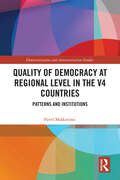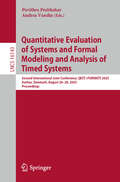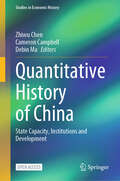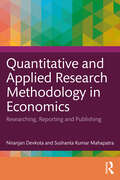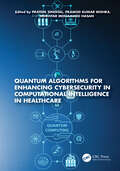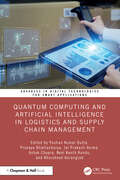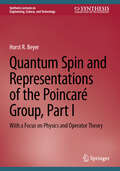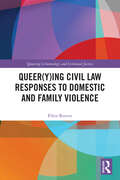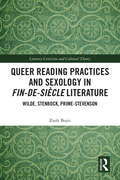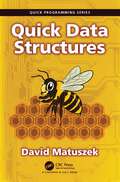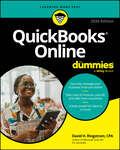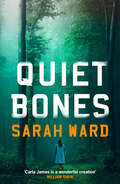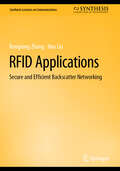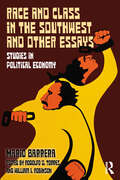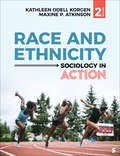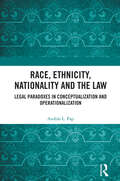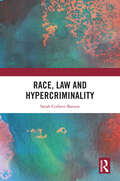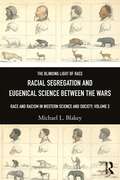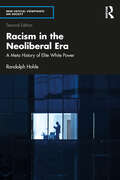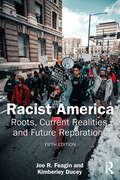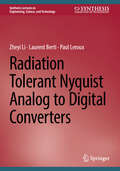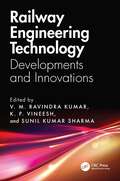- Table View
- List View
Quality of Democracy at Regional Level in the V4 Countries: Patterns and Institutions (Democratization and Autocratization Studies)
by Pavel MaškarinecThis book systematically examines regional-level qualities of democracy – representation, participation, and competition – in four countries of Central and Eastern Europe between 1994 and 2022, from the establishment of regional self-government to the present day.Focusing on their common EU accession as representing a critical juncture in their processes of consolidation and/or destabilization of liberal democratic patterns of government on both national and subnational levels, the book applies a conceptual framework on the quality of subnational democracy. It provides a clear methodological approach to observing quality and the variability in quality of democracy across various regions and its transformation through long-term comparisons. As such, the book contributes to understanding some of the processes of more than 30 years of Central and Eastern European regional politics, offering conceptual clarifications applicable to research conducted in other contexts.This book is of key interest to scholars and students of democracy, electoral politics, Central and East European politics, local politics, representation, and more broadly, comparative politics.
Quantitative Evaluation of Systems and Formal Modeling and Analysis of Timed Systems: Second International Joint Conference, QEST+FORMATS 2025, Aarhus, Denmark, August 26–28, 2025, Proceedings (Lecture Notes in Computer Science #16143)
by Pavithra Prabhakar Andrea VandinThis book constitutes the proceedings of the Second International Joint Conference on Quantitative Evaluation of Systems and Formal Modeling and Analysis of Timed Systems, QEST+Formats 2025, which took place in Aarhus, Denmark, during August 2025. The 26 full papers included in these proceedings were carefully reviewed and selected from 57 submissions. They focus on up to date research in quantitative evaluation of systems and formal modeling and analysis of timed systems.
Quantitative History of China: State Capacity, Institutions and Development (Studies in Economic History)
by Debin Ma Zhiwu Chen Cameron CampbellThis Open Access book marks the beginning of a new era in the study of Chinese history. Since the beginning of the computer age, quantitative techniques have been increasingly used to study specific topics like family, population, and living standards in China's past. However, sample sizes have usually been small due to either historical archives' availability constraints or limited human processing capacity. With much increased computing power and machine-assisted reading/processing capacity, many big historical databases have become available, offering quantitative historians and social scientists great opportunities to study China's past development experience. This volume showcases a collection of new findings concerning China's political, social, and economic history and typically based on newly constructed large historical datasets. Most of the work has involved an interdisciplinary team of economists, sociologists, political scientists, historians and econometricians, demonstrating how new big data and quantitative methods may be brought to bear on some of the biggest questions related to China's development over the past three millennia and on the implications of distant past events on contemporary China. Topics covered range from the roles of war, state formation, religion, culture, finance and institutions in long-run development and technological innovations, to regicide history, to the organization and capacity of the bureaucracy. Contributors include leading figures in the quantitative study of China's long-run socioeconomic and political history. This volume will be of value to anyone with an interest in Chinese economic, political, social and/or institutional history as well as anyone interested in quantitative history more generally.
Quantitative and Applied Research Methodology in Economics: Researching, Reporting and Publishing
by Sushanta Kumar Mahapatra Niranjan DevkotaThis book is an illustrative and comprehensive guide designed to help readers understand and navigate the complex world of academic writing and research in economics.Written by experienced researchers, this book offers theoretical and practical insights into the research process. It provides an understanding of the foundations of the research process like research design, methodology, problem definition, data collection, and analysis, among others. The authors also share insights into the process of preparing, proofreading, and publishing academic papers. With their experience in the field of academic research to this book, they provide practical examples and step-by-step guidance to assist in research-related issues. The section on how to prepare and publish academic papers is a must-read for students and early-career researchers, as it offers valuable guidance on how to succeed in the highly competitive world of academic publishing.With its clear and concise writing, this book will be an indispensable resource for undergraduate and postgraduate economics students, teachers, independent readers, and early-career researchers as well as those seeking a deeper understanding of research methodology in economics.
Quantum Algorithms for Enhancing Cybersecurity in Computational Intelligence in Healthcare
by Pramod Kumar Mishra Singhal, Edited by Prateek Mokhtar Mohammed HasanThis book explores the exciting field of quantum computing, which is changing how we approach computation. It covers the basics, cybersecurity aspects, advanced machine learning techniques, and the many ways quantum computing can be used. Quantum computing is much more powerful than traditional computing. The book starts by explaining the core concepts like qubits, quantum gates, superposition, entanglement, quantum memory, and quantum parallelism. One important area is how quantum computing can improve machine learning for cybersecurity. It can handle huge amounts of data and find complex patterns faster than regular computers. This is especially useful for finding cyber threats in real time, such as spotting unusual activity in healthcare networks that might mean a security breach. Quantum machine learning can help healthcare organizations better defend against advanced cyberattacks that try to steal patient data. The book also looks at how quantum computing is changing cybersecurity itself.It discusses quantum cryptography, post-quantum cryptography, and secure communication, explaining how quantum computing is leading to new ways of encrypting data, detecting threats, and protecting information. Beyond cybersecurity, the book shows how quantum computing impacts many other fields, such as medicine, finance, materials science, and logistics. It is poised to revolutionize artificial intelligence (AI) in healthcare and many other sectors. Because quantum computing is constantly developing, with discoveries and new applications happening all the time, this book brings together researchers from universities and industries to share their latest findings. It aims to help shape the future of this technology. The book offers a solid foundation, detailed explanations of advanced techniques, and a fascinating look at how quantum computing is being used in the real world. As quantum computing becomes easier to access through new tools and cloud platforms, this book hopes to inspire new research in AI and spark innovative applications that were previously thought impossible.
Quantum Computing and Artificial Intelligence in Logistics and Supply Chain Management (Advances in Digital Technologies for Smart Applications)
by Pushan Kumar Dutta, Pronaya Bhattacharya, Jai Prakash Verma, Ashok Chopra, Neel Kanth Kundu and Khursheed AurangzebThis book discusses the transformative potential of quantum computing in reshaping the landscape of supply chain management. It bridges the gap between these two dynamic fields, offering a comprehensive guide to the application of quantum principles in supply chain operations. Through detailed examples and case studies, it highlights how quantum computing can tackle industry-specific issues, such as managing global supply chain disruptions, enhancing production schedules, and enabling real-time decision-making. This book is for researchers, professionals, and technologists interested in quantum computing and supply chain practices.Features: Provides an in-depth analysis of quantum computing technologies and their capacity to solve complex optimisation problems at scales unimaginable with traditional computing Examines the impact of quantum computing on manufacturing and logistics, with a focus on sectors such as automotive and aerospace Real-world scenarios illustrate how quantum solutions can streamline operations and drive efficiency Explores quantum algorithms and their use in addressing challenges like route optimisation, inventory management, and demand forecasting, offering strategies to reduce costs and improve resilience Considers the current limitations, ethical implications, and the path to widespread adoption of quantum computing in supply chains, emphasising the need for interdisciplinary collaboration
Quantum Spin and Representations of the Poincaré Group, Part I: With a Focus on Physics and Operator Theory (Synthesis Lectures on Engineering, Science, and Technology)
by Horst R. BeyerThis book discusses how relativistic quantum field theories must transform under strongly continuous unitary representations of the Poincaré group. The focus is on the construction of the representations that provide the basis for the formulation of current relativistic quantum field theories of scalar fields, the Dirac field, and the electromagnetic field. Such construction is tied to the use of the methods of operator theory that also provide the basis for the formulation of quantum mechanics, up to the interpretation of the measurement process. In addition, since representation spaces of primary interest in quantum theory are infinite dimensional, the use of these methods is essential. Consequently, the book also calculates the generators of relevant strongly continuous one-parameter groups that are associated with the representations and, where appropriate, the corresponding spectrum. Part I of Quantum Spin and Representations of the Poincaré Group specifically addresses: conventions; basic properties of SO(2) and SO(3); construction of a double cover of SO(3); SU(2) spinors; continuous unitary representation of SU(2); basic properties of the Lorentz Group; unitary representation of the restricted Lorentz Group; an extension to a strongly continuous representation of the restricted Poincaré Group; and an extension to a unitary/anti-unitary representation of the Poincaré Group.
Queer (Queering Criminology and Criminal Justice)
by Ellen ReevesQueer(y)ing Civil Law Responses to Domestic and Family Violence offers unique, in-depth insights into the experiences of LGBTQ+ victim-survivors who have engaged with civil protection order systems.Drawing on data from an Australian study following the experiences of LGBTQ+ victim-survivors of domestic and family violence who engaged with Victoria’s civil protection order system, this book adopts a feminist, queer and trans abolitionist perspective to challenge the assumption that the best response to LGBTQ+ domestic and family violence is a legal one. Problematising responses that fundamentally require increased investment in policing, courts and prisons despite the risks this poses to marginalised individuals and communities, this book centres queer criminology as a framework through which we can situate and critique the rigid victim/perpetrator binaries that are so characteristic of legal responses to violence. This same criminological framework also provides the tools and knowledge needed to envision an alternative, community-oriented response to harm—within and beyond queer communities. In this way, the book presents queer criminology not only as a way of understanding LGBTQ+ experiences, but also as a means for analysing the broader shortcomings of a system that more often exacerbates risk of harm than minimises it.Queer(y)ing Civil Law Responses to Domestic and Family Violence will be useful for students and scholars of LGBTQ+ violence, as well as a valuable resource for policy makers, legal and specialist practitioners and advocates considering how best to respond to LGBTQ+ domestic and family violence.
Queer Reading Practices and Sexology in Fin-de-Siècle Literature: Wilde, Stenbock, Prime-Stevenson (Literary Criticism and Cultural Theory)
by Zsolt BojtiThis book scrutinises the production and transnational distribution of sexological knowledge at the turn of the century. The works of three transnationally mobile authors are in the focus: The Picture of Dorian Gray (1890/1891) and Teleny (1893) by, and attributed to, Oscar Wilde; ‘The True Story of a Vampire’ (1894) by Count Stanislaus Eric Stenbock; and Imre: A Memorandum (1906) by Edward Prime-Stevenson. The textual analysis is governed by references in all four works to Hungarian culture to demonstrate how they conceptualised ‘Hungarianness’ and same-sex desire simultaneously in the light of the new classificatory science of sexualities coming from German-speaking Central Europe. By foregrounding a timely literary angle and a ‘culturalist’ approach, this book offers non-Anglocentric insights, not bound by either language or nationality, to shed new light on the interdisciplinary reading practices of late-Victorian subjects and the ways they contributed to the emergence of fin-de-siècle queer fiction.
Quick Data Structures (Quick Programming)
by David MatuszekIf you want to upgrade your programming skills, the most important thing you need is a solid understanding of fundamental data structures. The proper choice of data structures distinguishes excellent programmers from merely competent ones.As an experienced programmer, you use data structures—at least arrays—all the time. However, you may not be familiar with hash tables, trees and binary trees, priority queues, directed and undirected graphs, and other data structures at your disposal.A good choice of data structures will simplify your job, not complicate it. Your code will be not only faster but also easier to understand and debug. There is no downside to using the right data structures for the job.This book Provides an understanding of the fundamental building blocks of data structures Describes the construction and use of all common data structures Explains the simple math required for selecting efficient data structures Equips you with everything you need to choose data structures or devise appropriate new ones
QuickBooks Desktop All-In-One For Dummies
by Stephen L. NelsonAn all-encompassing guide to a popular desktop accounting software QuickBooks Desktop All-in-One For Dummies clearly guides you on how to manage your business finances through QuickBooks Desktop. This comprehensive resource walks you through advanced features and overall layout, so you can maximize the value this software brings to your business. Feel confident invoicing customers, paying vendors, tracking inventory, do-it-yourself payroll, preparing financial statements and reports, creating a business plan forecast, and more. Plus, you'll get helpful tips for protecting your financial data and troubleshooting any potential snags along the way. Inside: Get started with QuickBooks Desktop and set up your accounting system Get easy-to-follow instructions for saving time with easy bookkeeping and automated features Learn to use advanced features as your business grows, so you can scale for the future Know your tax and reporting requirements From QuickBooks Desktop setup and bookkeeping basics to importing your data and performing all the tasks you need to keep things running smoothly, QuickBooks Desktop All-in-One For Dummies is your go-to
QuickBooks Online For Dummies, 2026 Edition
by David H. RingstromStep-by-step guidance on the latest version of the popular cloud accounting app QuickBooks Online For Dummies, 2026 Edition helps you save time and money. This beginner-friendly guide walks you through the basic setup of the online accounting software. Plus, this resource provides detailed guidance on key features, so you know how to navigate your financial data with ease. With QuickBooks Online For Dummies, 2026 Edition, you'll discover how to use any device to: view and update records, create invoices, record sales, pay bills, manage inventory, print checks, process payroll, prepare tax returns, balance accounts, generate financial reports, and beyond. Best of all? Everything's backed up in the cloud, so you'll get the peace of mind that comes with secure data. Use this Dummies guide to get up and running with QuickBooks Online. Inside: Make the switch to QuickBooks Online, or set up your business finances from scratch Get easy-to-follow instructions for accessing your data remotely and saving time with automated features Understand the new interface and the latest features, including Project Center and AI integration Stay on top of your budget, your taxes, and your reporting requirements QuickBooks Online is easy to use for any type of business, and QuickBooks Online For Dummies makes it even easier.
Quiet Bones: A brand new addictive and gripping crime thriller for fans of the Temperance Brennan series (Carla James Crime Thrillers)
by Sarah WardA dead child. A missing student. A darkness at the heart of Jericho College. When the body of a baby is found wrapped in a swan’s wing deep in the woods, archaeology professor and expert consultant Carla James is brought in to assist on the case. The unusual burial must signify something, but what exactly is unclear. Meanwhile, a student from Jericho College has gone missing. Police say she left of her own accord, but this doesn’t seem right to Carla. The young woman didn’t tell anyone she was leaving. No one has heard from her since. And she’s not the first student to disappear. As Carla delves further into both cases, she finds a rotten history beneath both the college’s and the town’s facade, perpetuated by lies and cover-ups. How deep does the corruption go? A gripping and unsettling crime thriller about privilege and the dark underbelly of institutions we so easily trust. Perfect for fans of Kathy Reichs and Elly Griffiths. Praise for Sarah Ward 'Carla James is a wonderful creation' William Shaw 'Dark, engaging and beautifully written' Michael Wood 'Addictive' Marion Todd 'Strongly atmospheric' Crime Time 'Clever and compelling' Woman's Weekly
RFID Applications: Secure and Efficient Backscatter Networking (Synthesis Lectures on Communications)
by Hao Liu Rongrong ZhangThis book introduces current efficient and secure backscatter networking schemes for RFID. The authors integrate these schemes with a concrete example, namely RFID-based missing item detection. The book presents a large palette of tools indispensable in the RFID-based passive IoT (such as compute complexity analysis, approximate algorithm design, the probabilistic data structure, and the protocol stack in COTS and software-defined RFID tags) and how these tools can be carefully tuned and adapted to be practically applied in RFID systems. The book elaborates the state-of-the-art research bringing the conventional data structure and traffic engineering technology in the core network into the emerging IoT applications of RFID. This does not only boost the performance for RFID systems, but also inspires new research directions. The authors believe that this book will interest researchers, professionals, and graduates working in RFID system design and engineering, low-power IoT as well as other related fields.
Race and Class in the Southwest and Other Essays: Studies in Political Economy
by Mario BarreraIn Race and Class in the Southwest and Other Essays, Mario Barrera puts forth his seminal theory of racial inequality based on a synthesis of class and colonial analysis, together with several essays and selections from Barrera’s memoir that show how his thinking developed throughout his work.Reprinted here for the first time after becoming a modern classic of Chicano studies, Race and Class in the Southwest focuses on the economic foundations of inequality as they have affected Chicanos in the Southwest from the Mexican-American War to the present. Barrera reviews the economic history of Chicanos, their relegation to a subordinate position in the labor force segmented along racial lines, their displacement from the land, the effects of waves of immigration from Mexico, the role of an emerging Chicano middle class, and state policies designed to reproduce the subordinate status of Chicanos. He reviews competing theories of racial inequality and concludes that an “internal colonialism” model that focuses on the institutional subordination of Chicanos offers the greatest explanatory value for understanding the political economy of Chicanos in the Southwest.The editors, Rodolfo D. Torres and William I. Robinson, provide both an important historical and contextual introduction to the work, as well as thorough annotation that brings the scholarship into contemporary conversation with further theoretical development and highlights Barrera’s significant contribution to recent and new debates that reflect his legacy at a time of rising social inequalities, political conflict, and mass migration into the United States from Latin America.
Race and Ethnicity: Sociology in Action
by Kathleen Odell Korgen Maxine P. AtkinsonRace and Ethnicity: Sociology in Action is an innovative text that combines comprehensive coverage of race and ethnicity content with active learning exercises, seamlessly integrated into the chapters. The book is written by a team of experienced instructors who use active learning techniques in their own classrooms. These contributors expertly weave together content material, active learning exercises, discussion questions, real-world examples of sociologists in action, and information on careers that use sociology. The Second Edition includes updated data, figures, and examples, as well as new information on many topics, including interracial relationships, immigrant groups, diversity among Asian Americans, racial discrimination in housing, and building coalitions for racial justice.
Race and Ethnicity: Sociology in Action
by Kathleen Odell Korgen Maxine P. AtkinsonRace and Ethnicity: Sociology in Action is an innovative text that combines comprehensive coverage of race and ethnicity content with active learning exercises, seamlessly integrated into the chapters. The book is written by a team of experienced instructors who use active learning techniques in their own classrooms. These contributors expertly weave together content material, active learning exercises, discussion questions, real-world examples of sociologists in action, and information on careers that use sociology. The Second Edition includes updated data, figures, and examples, as well as new information on many topics, including interracial relationships, immigrant groups, diversity among Asian Americans, racial discrimination in housing, and building coalitions for racial justice.
Race, Ethnicity, Nationality and the Law: Legal Paradoxes in Conceptualization and Operationalization
by András L. PapThis book provides a complex insight into how law, as a distinct tool and technology, conceptualizes and operationalizes race, ethnicity and nationality. The focus of the comparative project, by bringing examples from five continents and scores of jurisdictions, as well as showcases for hybrid, intersectional groups, is specifically the morphology and dynamics of legal categorization. Separate discussions concentrate on conceptualizing groupness and membership, as well as agency and contestation. The book shows that although identity politics has dominated recent decades, ethno-racial self-identification is not the only operationalizing model legal regimes apply, especially with the recent boost in artificial intelligence (AI), and bio-genetic research. Examples for the “re-biologization” of ethno-racial conceptualization are brought from a wide range of legal regimes, including citizenship, anti-discrimination, asylum, and Indigenous law. The work provides a journey through the administrative-political construction and contestation of ethno-racial classifications, with particular attention paid to the concepts of free choice of identity, covering, and fraud, as well as the arbitrariness, the historical path dependence, and the role of merit in conceptualization. While the starting point of the book is to capture ethnicity as a category of law, it shows how legal conceptualization and operationalization are intertwined with categories of analysis and experience. The methodology applied is comparative constitutional and international law, but the research will have wider interdisciplinary appeal offering a novel perspective for a broad audience in social sciences and humanities.
Race, Law and Hypercriminality
by Sarah Corbett-BatsonThis book considers how neoliberal criminal law constructs racialised ‘hypercriminals’.In a world of fake news and virtual reality, where social media posts seem more real than the materiality of racial capitalism, this book develops the idea of ‘hypercriminality’, as a means of explaining how racial disproportionalities in the criminal legal system persist, despite discourses of a post-racial meritocracy. Drawing on critical race theory, the work of Judith Butler, and Jean Baudrillard’s conception of the hyperreal, the book considers how neoliberal legal discourse constructs and reproduces hyperreal racialised legal subjects. The simulated violent figure of the racialised gang member, rioter, drug dealer, or sexual predator is made to appear ‘real’ through legal and evidential concepts such as dangerousness or bad character. The belief that this simulation is real is deployed to justify the carceral state and masks the structural, and racialised, violence of capitalism itself. Revealing the ‘hypercriminality’ of racialised legal subjects, the book thus offers a timely critical legal intervention that aims to advance the urgent project of decarceration, abolition, and transformative justice.The book will appeal to scholars and students working in the areas of criminal law and evidence, criminology, criminal justice, socio-legal studies, and critical race theory.
Racial Segregation and Eugenical Science Between the Wars: Race and Racism in Western Science and Society, Volume 2
by Michael L. BlakeyThis volume examines the rise and decline of racial science and its relationship to the political and social imposition of Jim Crow in the American South, a racialized code of laws grounded upon an inherently racist and prejudicial pseudoscience. The author argues, here, that the study of human beings within the emerging 18th‑ and 19th‑century institutions of Western science was corrupted by the limited social intuitions of its enslaving, colonizing, and elitist members. Western science and White societies plowed forward in continued ideological adherence to a biodeterministic imagination: to justify slavery, then Jim Crow racial segregation, immigration restriction, and other deadly and exploitative "eugenical" solutions of Social Darwinist thought. The story is further complexified by the countervailing theories and voices of Black and Jewish intellectuals in the social and biocultural sciences in the 19th and 20th centuries such as Frederick Douglass, W.E.B. Du Bois, and Montague Cobb. These had profound consequences not only for the social sciences but also for the cultural life of Black Americans in the aftermath (and afterlife) of slavery. At the same time, even here, the author discloses that the racialized dimensions of social science could not be fully exorcised, as social science continued to construct "soft‑line racism" in that it selectively primitivized darker people and omitted White racism and colonialism from their human story. African American social scientists and historians brought White racism and Black modernity to the fore. Eugenics had begun to paint marginal White people (Jewish and Italian immigrants to the United States) as natural inferiors to "Nordics" or "Aryans" with devastating consequences in World War II Europe. As the War ended, the world community began its turn against racism in science and society. In constructing this historical and sociological counternarrative, the author provides a critical new social history that illuminates a tangled and turgid past for contemporary readers, students, and researchers with vital insights for anthropology, sociology, history, cultural studies, philosophy, and American studies.
Racism in the Neoliberal Era: A Meta History of Elite White Power (New Critical Viewpoints on Society)
by Randolph HohleRacism in the Neoliberal Era explains how simple racial binaries like black/white are no longer sufficient to explain the persistence of racism, capitalism, and elite white power. The neoliberal era features the largest Black middle class in US history and extreme racial marginalization. Racial languages change the meaning of public and private – political economy’s two fundamental terms. Randolph Hohle focuses on how the origins and expansion of neoliberalism depended on a racial language of white-private/black-public. The language of neoliberalism explains how the white racial frame operates like a web of racial meanings that connect social groups with economic policy, geography, and police brutality. When America was racially segregated, elites consented to political pressure to develop and fund white-public institutions. The Black civil rights movement eliminated legal barriers that prevented racial integration. The elite white response to Black civic inclusion was to deregulate the Voting Rights Act and banking policy. Elites gave themselves tax cuts and implemented austerity measures on government programs to aid the poor. They privatized neighborhoods, schools, and social welfare, creating markets around poverty. They oversaw the mass incarceration and systemic police brutality against people of color. Citizenship was recast as a privilege instead of a right. Neoliberalism is the result of an elite white meta-strategy to maintain political and economic power.This new edition is thoroughly revised and updated to take account of the further history and debates over neoliberalism in the Trump and Biden eras and the significant social and political discussions around race and racism, policing, housing, health care, and citizenship as they interconnect with the American neoliberal economic and political system. The new edition will be a vital textbook for students, instructors, and researchers in sociology, politics, race, and economics.
Racist America: Roots, Current Realities, and Future Reparations
by Joe R. Feagin Kimberley DuceyThe fifth edition of Racist America is thoroughly revised and updated, focusing on systemic racism and antiracism issues, especially those arising since the fourth edition (2019). Expanding the discussion on racialized intersectionality, as well as on the white racial frame, elite-white-male dominance system, and antiracist action, this book details how these racism realities continue to impact black, Latino, Asian, Indigenous, and white Americans. The book explains how and why the Black Lives Matter movement and other antiracist protests have erupted; how and why Latino, Asian, and Indigenous Americans have responded to expanding racist discrimination; and how and why a diverse array of Americans has demanded major societal responses to dismantle entrenched white racism.
Radiation Tolerant Nyquist Analog to Digital Converters (Synthesis Lectures on Engineering, Science, and Technology)
by Paul Leroux Zheyi Li Laurent BertiThis book presents the detailed design considerations and techniques for radiation-tolerant (RT) Nyquist analog-to-digital converters (ADC). It begins with the fundamental radiation effects in space and its consequences in modern CMOS technology. Next, radiation effects on ADCs from the transistor level to the architectural level are examined and a detailed design tradeoffs and strategies for radiation-tolerant ADCs are described. The theory and hardening techniques are supported by measurement data from a high-performance RT-ADC prototype chip. Two important flows, which are a technology evaluation flow and an RT IC design flow, are also covered, in order to give a complete overview on how to achieve an effective RT circuits design.
Radicalized Real Estate Agents and the Rise and Resilience of the Australian Policy for Real Estate Carry (Routledge Studies in Governance and Public Policy)
by John S. WrightThis is a book about policy change that focusses on a single case study: the rise and resilience of the Australian policy for Real Estate Carry. The text tracks investments of meaning and identity in the Australian policies for Negative Gearing (1987) and the Capital Gains Tax Discount (1999), through which successive federal governments inadvertently created scope for a dangerous and inefficient Real Estate Carry Trade in the housing sector that has proven resilient to reform for a quarter century. Considering that Carry Trades inevitably create the conditions for their own collapse, the historical failure of Australian governments to achieve policy change is a serious issue for the country going forward. As they attempt to make their housing sector more stable, sustainable and equitable, Australian people may need to prepare for potentially dramatic changes to their economic and monetary system. The book also raises important implications for understanding the nature and workings of policy change in Australian politics and beyond. It is a valuable resource for scholars and students of political theory, public policy and Australian politics as well as policy practitioners, third sector groups and political parties interested in Australian and international housing policy.
Railway Engineering Technology: Developments and Innovations
by Sunil Kumar Sharma Ravindra Kumar, V. M. K. P. VineeshThis book presents advances in railway engineering, including railway wheels, wheel failure mechanisms, innovations in railway track designs, and axle failures. It covers rail–wheel traction characteristics under various environmental conditions for full-scale test conditions, including braking systems. It provides an understanding of the applications of digital twin technology in railway systems, predictive maintenance, performance optimization, and overall system efficiency. It also emphasizes sustainable practices, energy-efficient technologies, and environmental impact assessments.Features: Comprehensively reviews various aspects of railway engineering technology. Discusses major failure mechanisms and various types of braking systems. Covers the modernization of railways and high-speed trains. Explores emerging topics such as digital twin technology, sustainable practices, and autonomous technologies. Includes case studies of railway component failures and accidents. This book is aimed at researchers and professionals in railway and mechanical engineering as well as transportation systems.
